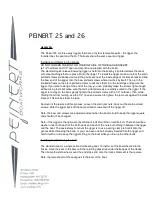
6.
Locate the head of the mainsail into
the mast track. Th
e Gnav bar must be on
the starboard side of the sail with sail
and halyard to the port side of the Gnav
bar. (fi gure 51)
7.
Hoist the mainsail using the main
halyard which exits the mast on the
lower port side.
Note:
Hoisting the mainsail is a two
person operation as assistance will be
required to feed the mainsail into the
mast track while the other person hoists
using the halyard (Th
is will prevent the
sail from pulling out of the track and
jamming which could cause luff rope
damage).
8.
When the mainsail is fully hoisted,
coil the halyard and store it in the
halyard bag on the underside of the gen-
naker sock. (fi gure 52)
1.
Secure the velcro tack around the mast.
(fi gure 53)
2.
Feed the plastic slug slide on the clew
outhaul to the cut out on the top of the
boom. (fi gure 54)
3.
Th
e outhaul line (blue) is then passed
through the eye in the sail (From port/
left to starboard/right side) and anchored
on the starboard/right side with a simple
knot located in the slot formed in the
boom end casting. (fi gure 55a)
(fi gure 55b )
4.
Outhaul tension is controlled using
the blue rope, cleat and fairlead at the
forward end of the boom. (fi gure 56)
10.Outhaul
11. Cunningham
1.
Pass the rope at the end of the
cunningham purchase system through
the eye at the bottom of the mainsail luff
(from starboard/right hand to port/left
hand side).
2.
Anchor the end of the cunningham
purchase system by sliding a half hitch
knot into the mast track just below the
gooseneck. (fi gure 57)
3.
Cunningham tension is controlled us-
ing the blue rope cleat and fairlead block
on the top of the centerboard case on the
starboard/right hand aside of the boat.
(fi gure 58)
12. Single Line Reefi ng
1.
Rig the single line reefi ng.
2.
Although single line reefi ng is only
applicable to the standard Vago, you will
fi nd a pocket at the forward end of the foot
of both standard and Race mainsails (port
side) to tidy the loose end of the single line
reefi ng system. (fi gure 59)
3.
Single line reefi ng tension is controlled
using the white rope, cleat and fairlead at
the forward end of the boom. (fi gure 60)
13. Single Line Reefi ng Instructions
AFT/REAR
BOOM END
FORWARD
BOOM END
Reefi ng Line
Routing
LINES EXIT BOOM ENDS
FROM STARBOARD
SHEAVES
PLACE FORWARD
REEFING LINE END
IN THE PORT SIDE
BOOM END NOTCH.
SECURE AFT REEFING
LINE END AROUND
THE BOOM USING A
BOWLINE.
REEFING LINE
OUTHAUL
(PORT)
fi gure 51
fi gure 52
fi gure 53
fi gure 54
fi gure 55a
fi gure 55b
fi gure 56
fi gure 57
fi gure 58
fi gure 59
fi gure 60




























